 Architect's Drawing - Exterior
Architect's Drawing - Exterior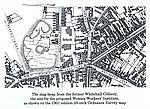 Map showing the slag-heap on which the Institute was built
Map showing the slag-heap on which the Institute was built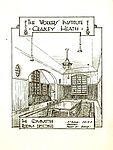 Architect's Drawing - Meeting Room
Architect's Drawing - Meeting Room Ornate Tile sign on the front of the Institute building
Ornate Tile sign on the front of the Institute building A Bound Bundle of sticks ?
A Bound Bundle of sticks ?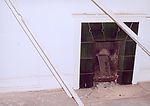 Fireplace
Fireplace 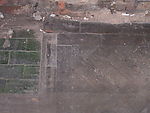 Typical Flooring
Typical Flooring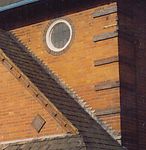 Decorative Brick Work
Decorative Brick Work

The Institute was built in an Arts and Crafts' style. The Arts and Crafts Movement was most active between 1880 and 1920, and was an ideology rather than simply a design style. The Movement rejected the mass production and pollution of the Victorian Age, and aimed to encourage and reinstate handicrafts and the use of natural materials and forms. Women were, for the first time, seen as important both as artists and as customers.
The Institute's steeply pitched, tiled, roof with gables and dormers, decorative brick and tile work, and leaded windows, are typical of the Arts and Crafts' style of architecture. It is an unusual style to be found in the Black Country, though there are other Workers’ Institutes around the country of similar design.
We do not know why this style was chosen. Perhaps there is a link between the Arts and Crafts' support for hand crafted work, and the skilled work of the hand made chain workers, whose strike fund surplus helped to build the Institute. Another possible link may be that Birmingham had an active Arts and Crafts Movement, leading to the setting up of the Birmingham Guild in the 1880s. It still existed in some form until the 1950s.
We also know that the architect, A.T. Butler, was a member of the Worcestershire Council for the Preservation of Rural England, a charity whose beliefs are in some part similar to the philosophy of the Arts and Crafts Movement.
Arts and Crafts' buildings often have decorative exteriors. The pictures show an ornate tile sign depicting a symbol, possibly of a bound bundle. This is similar to the bundle shown on the National Federation of Women Workers' poster. Does the bundle represent the bound iron rods, that were delivered to the workshops to later become chains? Or does it represent the strength of the women standing together? As Mary Macarthur would tell crowds during the 1910 strike, “a bundle of sticks is much stronger when bound together.”
Though there is limited evidence of the original interior decoration, the architect's sketch shows a simple, stylish scheme. The interior is most likely to have been designed "fit for purpose", a vital part of the Arts and Crafts' philosophy, probably giving a simple, well planned interior, suited to the use as a meeting hall, office, leisure and entertainment space.
The fireplace of green-glazed interlocking jigsaw shaped tiles in the newsroom is of a style found in other Arts and Crafts' buildings, such as Blackwell in Cumbria. The flooring is another typical example of Arts and Crafts' style, with parquet flooring meeting floor tiles of a distinctive green.
Rollover the captions in the box to see the available images in thumbnail format, click the caption to see the full-size image
| Reference: | 662 |
| Keywords: | |
| Archive Ref: | 2004/768/001 |
| Updated: | Thu 22 May 2008 - 1 |
| Interpretation written by | Jenny Ermoyenous |
| Author's organisation | Curatorial |
| Organisation's website |